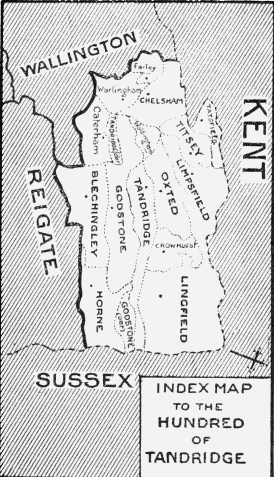A History of the County of Surrey: Volume 4. Originally published by Victoria County History, London, 1912.
This free content was digitised by double rekeying. All rights reserved.
'The hundred of Tandridge: Introduction and map', in A History of the County of Surrey: Volume 4, (London, 1912) pp. 251-252. British History Online https://www.british-history.ac.uk/vch/surrey/vol4/pp251-252 [accessed 24 April 2024]
THE HUNDRED OF TANDRIDGE
CONTAINING THE PARISHES OF
| BLECHINGLEY | GODSTONE | TANDRIDGE |
| CATERHAM | HORNE | TATSFIELD |
| CHELSHAM | LIMPSFIELD | TITSEY |
| CROWHURST | LINGFIELD | WARLINGHAM |
| FARLEY | OXTED | WOLDINGHAM |
This hundred has remained practically unchanged in its extent since the Domesday Survey. In 1086 no mention is made of Crowhurst, Horne or Lingfield, but of these Crowhurst was probably included in the territory comprised by one of the large manors of Tandridge or Oxted; Horne was certainly part of Blechingley, and Lingfield, which by a post-Domesday authority (fn. 1) is said to have been granted to the New Minster at Winchester under Edgar, seems to have been omitted. One manor, tentatively identified as that of Horley, now in Reigate Hundred, is mentioned under Tandridge Hundred in the Survey, a location which may have been due to its position on the borders of the two hundreds. (fn. 2) It is noticeable that about one-sixth of all the serfs in Surrey belong to Tandridge Hundred. (fn. 3)

INDEX MAP TO THE HUNDRED OF TANDRIDGE
Tandridge was from earliest times a royal hundred, (fn. 4) and there is little that is noteworthy in its history. The custody of the hundred was granted to Thomas Hunt in the reign of James I. (fn. 5)
In 1533 Sir John Gainsford of Crowhurst, writing to Cromwell, comments on the amount of crime and evil-doing which he had lately observed in the hundred, adding … 'if ye be not good master to the country where I dwell, I cannot tell how poor men shall live in quiet, for within these two years more unthrifty deeds have been done in the hundred of Tanredge than have been done in the whole shire.' (fn. 6)
The Parliamentary Survey of the hundreds of Reigate and Tandridge, 'late of Charles Stuart,' made in 1651, (fn. 7) records that the court leets for both hundreds were held at Undersnow (in Tandridge parish (fn. 8) ) at the usual times, and the lord might call or keep a court leet at any of the townships and tithings which paid a common fine. At the court held at Michaelmas constables and tithingmen for the past year were discharged and new ones sworn. The surveyors could not learn that there was any three weeks court for these hundreds, though they believed the lord thereof had the right to hold them if he chose. The courts were held by the sheriff of the county. Undersnow, called Hundredsnow in a deed of 1656, (fn. 9) was the place where three ways met at the south-east of Rooksnest Park. Mr. Glover, an antiquarian solicitor of Reigate, possessed the court rolls of the years 1704 to 1720, from which it appeared that constables and head boroughs were elected then for thirty-two parishes, boroughs or tithings in Tandridge, and for Chipstead, Buckland, Burstow and Gatton in Reigate Hundred. (fn. 10)
